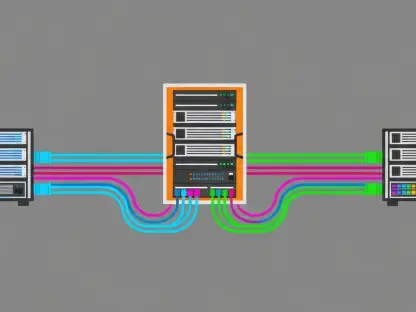In an era where data drives decision-making across industries, the role of IT managers in shaping effective data governance has never been more critical, especially as enterprises grapple with sprawling datasets and complex regulatory demands that challenge even the most robust systems. The sheer volume of information generated daily, coupled with the need for compliance and security, places immense pressure on organizations to establish robust frameworks that not only protect data but also unlock its strategic value. Gone are the days when governance was merely an IT concern tucked away in isolated departments; today, it demands a collaborative, business-aligned approach. As technology evolves with innovations like cloud computing and artificial intelligence, IT managers find themselves at the forefront of a paradigm shift, tasked with navigating historical challenges while embracing modern methodologies to ensure data remains a trusted asset. This discussion delves into actionable strategies that can empower IT managers to lead successful governance initiatives, fostering scalability and relevance in an ever-changing digital landscape.
Evolving Models of Data Governance
Transition from Centralized to Decentralized Frameworks
The journey of data governance within enterprises reflects a significant transformation, moving away from rigid, centralized structures toward more dynamic, decentralized models. Historically, IT departments held tight control over data through centralized governance offices, an approach that promised consistency but often stumbled due to limited business input and scalability constraints. This outdated model frequently left organizations struggling to adapt as data needs grew more complex. In contrast, the rise of decentralized frameworks, often termed “data mesh,” shifts ownership to business units, enabling them to manage data as products tailored to specific needs. This shift prioritizes accessibility and interoperability, ensuring that data serves practical purposes across diverse platforms. By empowering business stakeholders, enterprises can address immediate priorities while building a foundation for long-term governance success, a strategy that aligns with the rapid pace of technological advancement seen in tools like cloud-based data lakes.
Moreover, the adoption of decentralized models has been accelerated by cutting-edge technologies that simplify governance tasks. Solutions that automate data lineage tracking, quality assessments, and classification of sensitive information have become indispensable in supporting this transition. Such tools reduce the burden on IT teams, allowing them to focus on strategic oversight rather than manual processes. This technological support is critical in a decentralized setup, where multiple teams handle data independently yet must adhere to unified standards. The result is a governance structure that balances autonomy with accountability, fostering an environment where data accuracy and traceability are non-negotiable. For IT managers, understanding and leveraging these tools is essential to facilitate smooth collaboration across departments, ensuring that governance evolves from a restrictive mandate into a value-driven initiative that resonates with organizational goals.
Addressing Historical Challenges with Modern Solutions
Reflecting on past governance efforts reveals a landscape marked by inefficiencies that modern strategies aim to overcome. Centralized models often failed to deliver sustained support or adapt to the growing diversity of data use cases, leading to fragmented efforts that lacked business relevance. Today, IT managers can draw on lessons from these shortcomings by integrating governance with business objectives from the outset. The emphasis now lies in creating frameworks that are flexible enough to accommodate incremental progress rather than enforcing sweeping, all-at-once implementations. This pragmatic approach recognizes that not all data attributes need uniform management immediately, allowing enterprises to prioritize areas of greatest impact. By focusing on specific business-driven use cases, IT managers can demonstrate quick wins that build momentum for broader governance adoption.
Additionally, the integration of advanced analytics and artificial intelligence offers a powerful means to address historical gaps in data governance. These technologies enable predictive insights and automated compliance checks, reducing the risk of errors that plagued earlier systems. For instance, machine learning algorithms can identify patterns in data usage that signal potential security risks, allowing preemptive action. This capability transforms governance from a reactive process into a proactive strategy, aligning with the fast-paced demands of current enterprise environments. IT managers must champion the adoption of such solutions, ensuring that teams are equipped to handle the complexities of modern data ecosystems. By doing so, they can bridge the divide between past limitations and future possibilities, crafting governance models that are both resilient and responsive to evolving needs.
Strategic Approaches for IT Managers
Aligning Governance with Business Priorities
For IT managers steering data governance projects, a pivotal strategy involves aligning efforts closely with business priorities rather than treating governance as a standalone IT function. This “right-to-left” approach begins with engaging business sponsors to pinpoint critical initiatives that can benefit from robust data management. By breaking these initiatives into actionable use cases and mapping them to existing or new data products, governance becomes a direct enabler of tangible outcomes. This method stands in stark contrast to outdated, comprehensive rollouts that often overwhelm resources without delivering immediate value. Instead, focusing on business-centric goals ensures that governance remains relevant, fostering stakeholder buy-in and creating a cycle of continuous improvement that scales across the organization over time.
Furthermore, this alignment necessitates a cultural shift within enterprises, where data governance is viewed as a shared responsibility rather than an IT burden. IT managers play a crucial role in facilitating this change by fostering collaboration between technical teams and business units. Regular communication and joint planning sessions help ensure that governance policies reflect real-world needs, such as improving customer insights or streamlining operations. This collaborative mindset also mitigates resistance to governance initiatives, as stakeholders see direct benefits in their day-to-day work. By embedding governance into the fabric of business strategy, IT managers can transform it from a compliance checkbox into a competitive advantage, paving the way for data-driven decision-making that propels the organization forward.
Embracing Incremental Progress for Long-Term Impact
Another essential strategy for IT managers lies in embracing incremental progress rather than aiming for an all-encompassing governance overhaul from the start. Past attempts at sweeping implementations often faltered due to their complexity and lack of immediate results, leaving enterprises frustrated. In contrast, a phased approach tied to specific business needs allows for manageable steps that deliver measurable impact. By tackling high-priority data domains first, IT managers can address pressing challenges while building a framework that expands organically. This method not only conserves resources but also builds confidence among stakeholders, as early successes validate the governance effort and encourage wider adoption across different sectors of the enterprise.
Beyond the practical benefits, an incremental approach also aligns with the realities of modern data environments, where change is constant. IT managers must remain agile, adapting governance strategies as new technologies and regulations emerge. This flexibility ensures that each step forward is informed by current conditions, avoiding the pitfalls of rigid, long-term plans that quickly become obsolete. Additionally, leveraging feedback from each phase allows for continuous refinement, ensuring that governance evolves in lockstep with organizational priorities. Looking back, IT managers who adopted this measured approach in past projects often found that small, focused efforts laid the groundwork for comprehensive success, proving that patience and precision are key to overcoming initial hurdles and achieving sustainable data management.









